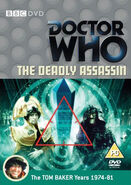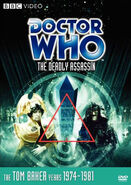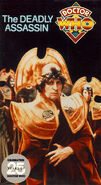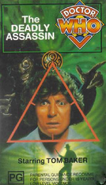Synopsis
"Through the millennia, the Time Lords of Gallifrey led a life of peace and ordered calm, protected against all threats from lesser civilisations by their great power. But this was to change. Suddenly and terribly, the Time Lords faced the most dangerous crisis in their long history…"
Plot
Part One
En route to Gallifrey in answer to the Time Lords' summons, the Doctor is struck with a premonition in which he appears to assassinate the Time Lord President from a gallery overlooking the Panopticon.
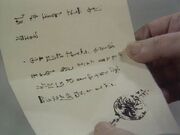
The Doctor's message to the Time Lords
The TARDIS lands in the security area of the Citadel, and Commander Hilred immediately impounds it and orders the arrest of its owner. The Doctor leaves a note on the console warning of his premonition, and manages to sneak out of the TARDIS into the Citadel. He is cornered by a guard, who then is shot dead by an unknown assailant.
The arrival of an unregistered TARDIS in a high-security area increases the tension on an already tense day - the President is resigning, and is about to name his successor. The Castellan Spandrell berates Hildred for his incompetence at letting the Doctor, a renegade who apparently is also a murderer, run loose in the capitol.
Hildred transducts the TARDIS into the capitol, unaware that the Doctor has sneaked back and hidden himself on board. Meanwhile, his movements are being monitored by a dark, robed figure and an unknown associate.
The Doctor infiltrates the resignation announcement by stealing a Time Lord's ceremonial robes. While trying to remain incognito in the crowded floor he encounters an old classmate, Runcible, now a newscaster, preparing his broadcast from the Panopticon floor. Runcible greets him coolly while waiting for a signal from a camera operator in the gallery. The Doctor looks up and is horrified to see a staser rifle fixed to the railing near the unattended camera. He causes a commotion as he charges through the room.
As the President enters and stands at the dais, the Doctor grabs the staser rifle. He aims and fires, and the President falls down dead.
Part Two
The Doctor is quickly apprehended by security. The assassination has thrown Gallifrey into a Constitutional crisis, as the President had yet to name his successor. Chancellor Goth, thought to have been the most likely successor, calls for prompt elections and opts to stand as a candidate. Goth also urges the Doctor's swift trial and execution.
At the trial, Goth's prosecution moves swiftly. The Doctor, however, invokes Article Seventeen of the Gallifreyan Constitution, naming himself as a candidate for President who thereby cannot be denied the right to make his claim. Goth is outraged, but Chancellor Borusa (the Doctor's former teacher at the Academy) acknowledges that the Article does give him protection. He is grudgingly given twenty-four hours to prove his innocence.
The robed figure is informed of the Doctor's use of the constitutional loophole by his associate. He had anticipated this. We see that the figure is a horribly disfigured and decaying husk.
Runcible, murdered.
The Doctor attempts to convince Spandrell and Coordinator Engin of his innocence; his shot was intended for the actual assassin standing in the crowd on the Panopticon floor, and someone is going through great lengths to frame him. He notes that the sights had been fixed on the rifle to intentionally throw off his aim. Spandrell confirms this by aiming at a target himself, and begins to believe the Doctor. They find the Doctor's original blast mark on the wall. The Doctor realizes that the gallery camera would have recorded the actual assassin. Runcible goes to fetch the recording disc from the camera, but screams with horror when he looks into the camera barrel, and is murdered by an unseen person. Running up to the gallery, they find the camera barrel empty except for the miniaturized corpse of the cameraman. The Doctor recognizes this as the work of his arch enemy, the Master, and reasons that he brought him to Gallifrey for a final showdown.
Spandrell and Engin cannot comprehend why there is no bio data extract for the Master in the APC Net (aka the Matrix), a network of past and present Time Lord minds that acts as an enormous database and future forecaster. The Doctor decides that there must be an unauthorized second access point into the Matrix, and that the Master had used this to forecast the assassination into his mind, and then wipe all trace from the Matrix. He reasons that either the Master or the assassin working with him must be inside the Matrix, so despite the stern warning from Spandrell, he interfaces with the Matrix to find him.
The Doctor finds himself in a vast, rapidly shifting terrain, the domain of the assassin. The two engage in a pitched battle of wills, the assassin possessing the definite advantage of having created the virtual reality world inside the Matrix.
Part Three
The Doctor manages to evade the various pitfalls laid for him inside the Matrix, which include being strafed by a biplane and tracked by the assassin, though his physical body (still in the APC room) is enduring a terrible and potentially lethal strain. Meanwhile, the assassin is finding the battle of wills extremely taxing as well. The Master increases the power, despite the assassin's plea that it will kill him. The Doctor begins to turn the tables on his assailant, firstly by booby trapping the hunter's equipment, then by avoiding the water poisoned by the assassin. He then improvises a blowpipe and shoots a poisoned dart at the assassin, but is wounded himself in the process.
As the Doctor comes closer to winning the conflict, the Master sends one of the chancellor's guards now under his power to the APC room to kill the Doctor. Engin spots the guard, Solis, tampering with the controls, which leads Spandrell to shoot Solis in order to protect the Doctor.
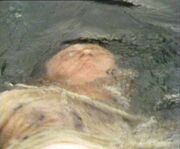
Goth, slipping below the water; drowning within the Matrix.
In the Matrix, the Doctor manages to gain the upper hand against the assassin, who reveals himself to be Goth. The Doctor tricks Goth into firing his rifle while surrounded by swamp gas. As the world around them erupts in chaos and flames, Goth seizes the Doctor and holds his head underwater, about to drown him.
Part Four
The Doctor throws him off and barely manages to escape from the Matrix. He revives in Spandrell's office, and informs the shocked Castellan of the assassin's identity. They trace the location of their lair, where they find the Master's lifeless body - he appears to have taken his own life. Goth, himself near death, reveals that he was power-hungry and bitter on learning he wasn't to be the President's successor. He had found the dying Master on planet Tersurus, his body at the end of his regeneration cycle, and brought him to Gallifrey to help him fulfill his scheme. However, Goth dies before he can reveal just what the Master's plan was.
Cleared of all charges, the Doctor still has lingering doubts. He wants to know the Master's plan, and doubts that he would accept death so easily. He reasons that the solution lies in the ceremonial relics given to the President upon induction, the Sash and Rod of Rassilon, and researches their links with ancient Gallifreyan mythology.
The Doctor's suspicions are confirmed when the Master is discovered to have faked his death. He steals the Sash and Rod, which are the keys to the Eye of Harmony, the heart of a black hole captured by ancient Time Lord Rassilon and source of Time Lord power. The Master seeks the power of the Eye to restart his regeneration cycle, even though Gallifrey would be destroyed. He uses the Rod to unlock the Eye of Harmony, hidden below the Panopticon floor, and begins to release its energy, which would be channeled through the Sash to rejuvenate him. The Doctor wrestles with him as the ground shakes around them. Before the Master can uncouple the last cable from the Eye, the Doctor pulls him away and he falls through a fissure in the floor. The Doctor reconnects the various cables, bringing the crisis to an end.

The Master as he departs Gallifrey in his TARDIS.
Borusa is appalled at the damage; half the capitol city lies in ruins, and countless lives are lost, but he accepts Spandrell's claim that the Doctor's actions prevented further catastrophe. Acknowledging their past relationship as teacher and student, Borusa gives him a grade of 9 out of 10. The Doctor departs in the TARDIS, but Spandrell discovers that the Master has survived and escaped in his own TARDIS.
Cast
- The Doctor - Tom Baker
- The Master - Peter Pratt
- Cardinal Borusa - Angus MacKay
- Castellan Spandrell - George Pravda
- Chancellor Goth - Bernard Horsfall
- Commander Hilred - Derek Seaton
- Commentator Runcible - Hugh Walters
- Co-ordinator Engin - Erik Chitty
- Gold Usher - Maurice Quick
- Solis - Peter Mayock
- The President - Llewellyn Rees
- Time Lord 1 - John Dawson
- Time Lord 2 - Michael Bilton
- Computer Voice - Helen Blatch
Crew
- Assistant Floor Manager - Linda Graeme
- Costumes - James Acheson, Joan Ellacott
- Designer - Roger Murray-Leach
- Fight Arranger - Terry Walsh
- Film Cameraman - Fred Hamilton
- Film Editor - Ian McKendrick
- Incidental Music - Dudley Simpson
- Make-Up - Jean Williams
- Producer - Philip Hinchcliffe
- Production Assistant - Nicholas John
- Production Unit Manager - Chris D'Oyly-John
- Script Editor - Robert Holmes
- Special Sounds - Dick Mills
- Studio Lighting - Brian Clemett
- Studio Sound - Clive Gifford
- Theme Arrangement - Delia Derbyshire
- Title Music - Ron Grainer
- Visual Effects - Len Hutton, Peter Day
References
Books
- The Book of the Old Time is mentioned.
The Doctor
- According to Coordinator Engin the Doctor " must have a phenomenal amount of Artron energy".
Galaxies
- The term Mutter's Spiral is used for the first time as a Time Lord reference for the location of Earth (presumed to refer to the Milky Way Galaxy).
Gallifrey
- Shobogans are hooligans on Gallifrey.
Gallifreyan artefacts
- The APC Net is part of (or possibly separate from) The Matrix.
- The Eye of Harmony sits below the Citadel on Gallifrey, and Rassilon was one of the creators of it.
Gallifreyan Chapters
- Prydonians, the 'notoriously devious' sect to whom the Doctor belongs, colour-coded scarlet and orange.
- Arcalians, who wear green.
- Patrexes, who wear heliotrope
Gallifreyan culture
- The Doctor arrives on Presidential Resignation Day.
- The Doctor invokes Article 17 of the Constitution, offering himself as a Presidential Candidate to avoid execution.
- The Doctor's trial is dated 309906.
Gallifreyan history
Gallifreyan organisations
- The CIA are mentioned.
Individual Gallifreyans
Planets
Time Lords
- The Time Lords possess a complete biographical history of the Doctor, and all Time Lords.
- The Time Lords whom the Master kills are not seen to regenerate.
- The number of regenerations (12) for Time Lords is stated.
TARDISes
- The Doctor's TARDIS is a type 40 protected by a 'double curtain trimonic barrier' which requires a cypher indent key.
Story notes
- Bernard Horsfall previously played Guilliver in The Mind Robber, one of the Time Lords in The War Games and a Thal Taron in Planet of the Daleks. These were also directed by David Maloney
- Roger Murray-Leach reused his symbol from Revenge of the Cybermen as the Seal of Rassilon.
- Mary Whitehouse complained particularly about the end of Part 3, with the Doctor being drowned, so much so the BBC edited their master tape (the episode was preserved albeit in lower quality in international copies).
- The story had a working title of The Dangerous Assassin.
- The title is a tautology - an assassin is, by definition, deadly. This redundancy was parodied in the spoof The Curse of Fatal Death.
- This is the first TV story to feature the Doctor without a companion, and the only one to occur during the 1963-89 original series. The 1996 telefilm and revival series would feature the Doctor on occasion collaborating with "one-off" companions (such as Donna Noble in The Runaway Bride), and in Midnight, the Doctor has an adventure by himself, away from his companion. All that said, The Deadly Assassin remains unique as the only televised Doctor Who adventure to date in which the Doctor appears but there is no companion or companion-surrogate at all.
- This story features an exclusively male cast, except for a female computer voice.
- This is the first story set entirely on Gallifrey.
- This is the only story where every character is of the same race (Gallifreyan).
- This story featured the first use of narration, by Tom Baker which began at the beginning of the first episode;
- Through the millennia, the Time Lords of Gallifrey led a life of peace and ordered calm, protected against all threats from lesser civilisations by their great power. But this was to change. Suddenly, and terribly, the Time Lords faced the most dangerous crisis in their long history...
- In Episode 1 Runcible appears to use the term "facelift" as slang for "Regeneration".
Ratings
- Part 1 - 11.8 million viewers
- Part 2 - 12.1 million viewers
- Part 3 - 13.0 million viewers
- Part 4 - 11.8 million viewers
Myths
- This is the only story to reference the fact that Time Lords get 12 regenerations and 13 lives. Recent interviews with the production team behind the 2005-present revival (including David Tennant in Doctor Who Magazine #415) have made it appear as if the allocation of 13 lives in this story is a piece of minutae unique to this story. In fact, the 13-life limit has been a major plot element of at least two other stories, both of which involve villains attempting to steal the Doctor's remaining regenerations: DW: Mawdryn Undead and the 1996 TV movie. Both productions also reference the 13-life limit in dialogue. A more subtle reference to this occurs in DW: The Next Doctor.
Filming locations
- Betchworth Quarry, Pebblehill Road, Betchworth, Surrey
- Wycombe Air Park, Clay Lane, High Wycombe, Buckinghamshire
- Royal Alexander and Albert School, Rocky Lane, Merstham, Surrey
- BBC Television Centre (TC3 and TC8), Shepherd's Bush, London
Production errors
- The guard the Master kills in episode one is seen alive and well in episode two.
- the corpse of the technician is clearly seen as an Action Man figure.
Continuity
- DW: The Keeper of Traken, Logopolis, and Castrovalva follow the Master's continuing quest for a new body, whilst The Five Doctors continues on this idea, as does the 1996 telefilm.
- PDA: Last of the Gaderene and EDA: Legacy of the Daleks explain how the Master became how he appears. However, in terms of televised adventures, there is no indication whether or not the Master seen here is necessarily the same incarnation of the Master as last seen portrayed by Roger Delgado in DW: Frontier in Space.
- Goth's brother Rath appears in NA: Blood Harvest.
- Engin reappears in EDA: The Eight Doctors.
- Artistic elements introduced in this story, particularly the Time Lord collars and the Seal of Rassilon, appear on multiple later occasions in stories featuring Time Lords.
- This story features the first voice over at the beginning of the episode. The second occurrence is DW: Doctor Who, and the third is DW: The End of Time.
- This story establishes that Time Lords do sometimes use proper names on their homeworld (previous uses have either been aliases, or of ambiguous origin such as Morbius; and rank-and-file Time Lords seen in stories like DW: The War Games and The Three Doctors had gone unnamed).
- Also established in this story is the fact that Time Lords are allotted twelve regenerations (for a total of thirteen lives), which becomes a major plot element hereafter, referenced in stories such as DW: Mawdryn Undead and the 1996 TV movie.
- This story introduces the iconic character of Rassilon, who would hereafter be referenced often. Rassilon would be seen via a form of projection in The Five Doctors, and seen in person in The End of Time. It also greatly expands on the Time Lord society and mythology that was hinted at in The Three Doctors and only briefly glanced in The War Games.
- Fans have theorised that the reason The Master's features look less distorted and eroded on Traken, is because during the process when The Master attempted to absorb the Eye of Harmony's energy in order to regenerate his physical form, he rejuvenated his body, but not fully enough to end the degeneration.
Timeline
For the Doctor:
- This story occurs after: DW: The Hand of Fear
- This story occurs before: TN: Ghost Ship
For the Master:
- This story occurs after: EDA: Legacy of the Daleks
- This story occurs before: DW: The Keeper of Traken
Home video and audio releases
DVD releases
- The DVD was released on 11th May 2009 in the UK.
Special Features include;
- Commentary by Tom Baker, Bernard Horsfall and Philip Hinchcliffe
- The Matrix Revisited Cast, crew and critics look back at the making of this story, featuring director David Maloney, designer Roger Murray-Leach and the founder of the National Viewers and Listeners Association, Mary Whitehouse
- The Gallifreyan Candidate A look at Richard Condon’s novel The Manchurian Candidate, a major influence on the plot of The Deadly Assassin
- The Frighten Factor What exactly is Doctor Who's "Frighten Factor"? A diverse panel of experts try to answer the question
- Radio Times Billings Listings for this story presented in a PDF file [DVD-ROM – PC/Mac]
- Photo Gallery
- Coming Soon Trailer
- Production Information Subtitles
- Easter Egg
- Editing for DVD release completed by Doctor Who Restoration Team.
VHS releases
- It was released in episodic format in the UK in October 1991. It was also re-released & remastered for the W H Smith exclusive The Time Lord Collection in 2002 with a better quality freeze frame cliffhanger for Episode 3.
- This story was released in the US March 1989 in edited omnibus format.
Novelisation and its audiobook
Main article: Doctor Who and the Deadly Assassin
- Novelised as Doctor Who and the Deadly Assassin by Terrance Dicks in 1977
External links
- The Deadly Assassin at the BBC's official site
- The Deadly Assassin at the Doctor Who Reference Guide
- The Deadly Assassin at Shannon Sullivan's A Brief History of Time (Travel)
- The Deadly Assassin at The Locations Guide
Template:Season 14
| ||||||||||||||||||||||||||||||||||||||||||||||||||||||||||||||||||||||||||||||||||||||||||||||||||||||||||||||||||||||||||||||||||||||||||||||||||||||||

